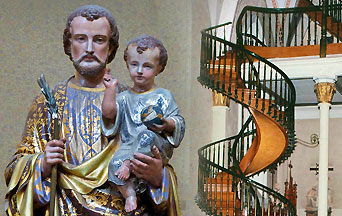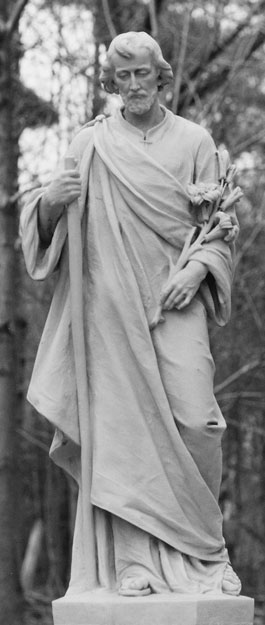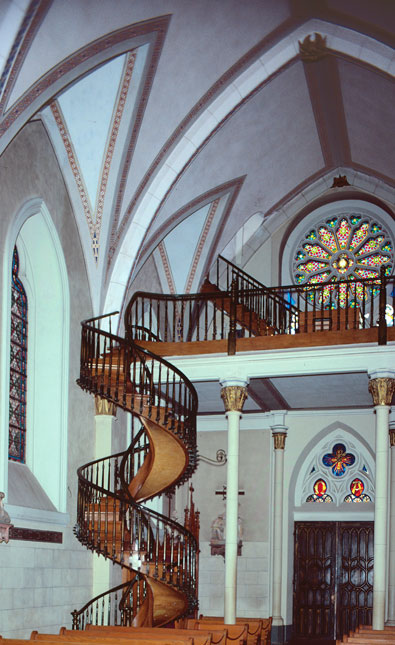
The early history of the American Southwest is marked by sublime and truly heroic adventures of ardent souls seeking to expand the Kingdom of Christ. The intensity of their faith and efforts is made manifest in the convents, chapels, and schools they founded—and sometimes in miracles God worked on their behalf. One such miracle, a permanent one, took place in what is now the State of New Mexico.
The Sisters of Loretto and Their Chapel
After three grueling months of travel by river and rail from Kentucky, four self-sacrificing religious of the congregation of the Sisters of Loretto at the Foot of Cross reached Santa Fe in 1853. There, at the request of the Bishop of Santa Fe, Jean-Baptiste Lamy, they opened a school for girls. This seed, sprouting and flourishing, exerted a great influence on the life and history of the city.
By 1873, to better accommodate their community, the sisters undertook construction of a new chapel, dedicated to Our Lady of Light. With its lancet arches and stained glass windows, it was to be reminiscent of the luminous Gothic splendor that arose in medieval Europe under the inspiration of the same Catholic Faith that the nuns were fostering in New Mexico.
Saint Joseph’s Eminent Sanctity and His Patronage in the Difficulties of the Present Times
But as construction neared completion, the sisters faced a problem.
Relative to its length of 75 feet and breadth of 25 feet, the chapel was quite high at 85 feet. So a staircase to the choir loft could not be built according to the customary patterns. One of the architects directing the project had died and the original plans could not be found. Various carpenters and other building specialists consulted for a solution did not know what to propose.

TFP headquarters, Spring Grove, Penn.
There was even talk of pulling down the choir loft.
The nuns saw no other recourse than a novena to Saint Joseph, the carpenter of Nazareth. To kneel, to beg, to trust: Are these not the proper dispositions of Catholic piety?
A Carpenter Knocks
No sooner was the novena completed than a man knocked at the convent door. He had heard of their predicament, he explained, and being a carpenter, came to offer his help.
The sisters immediately accepted his offer.
With the few primitive tools, a saw, a hammer and a T-square, which he brought with him on his donkey, he set to work. Some sisters also remembered some tubs of water to soak the wood to make it pliable.
Laboring quietly and diligently, always with a recollected air, the unknown carpenter soon completed a beautiful spiral staircase. Made entirely of wood held together with wooden pegs, having neither nails nor screws, it ascends to the choir loft in two complete 360-degree turns with no central axis for support.
Here Is the Story of Saint Joseph’s Miracle at the Santa Fe Café
When he had finished the essential part of the staircase—everything except a handrail—the carpenter departed. He presented no bill to the sisters and requested no payment. And he never returned.
The Mother Superior tried to locate him in the area, but looked and inquired in vain. No one knew him at all. She visited the local lumber yard to pay for the wood but they knew nothing of such an order. The grateful sisters, though disappointed that the carpenter had slipped away, weren’t surprised; had they not prayed to Saint Joseph?
Puzzled Experts
But architects, carpenters, and the like were certainly mystified. They came in increasing numbers to examine the technique that allowed such a tall staircase, with two complete turns, to stand with no central axis! They marveled further on hearing that the stairs were being regularly used by the sisters and pupils. According to the professionals, the spiral should have collapsed the minute the first person tried to climb it! And so the stairway continued to be used for a century.

The experts also admired the geometric perfection of its design, obtained solely with manual skill and rudimentary tools. They were no less perplexed at the wood used, unknown to them and the area.
One aspect of the staircase may have added to the musings of the specialists or may have been overlooked, but the sisters noticed and understood it completely. The staircase has 33 steps, significantly corresponding to the “perfect age” at which Our Lord expired on the cross for our redemption.
Silent Witness to This Day
In 1968, due in part to the crisis occasioned by progressivism, then already taking a serious toll on the Church’s religious communities, the Sisters of Loretto reduced their activities in Santa Fe. The School of Our Lady of Light closed its doors. Its building, sold three years later, was remodeled and opened as a hotel.
The chapel remains intact, but is now a museum. Visitors, who must purchase tickets to enter the chapel, can listen to a recorded history as they contemplate its interior. While curiosity and analysis lead many to admiration and piety, skeptics are left in silent perplexity.
In 1984 Professor Mary J. Straw published a comprehensive study on the chapel titled, Loretto: The Sisters and Their Santa Fe Chapel. And tourist guides still point to the chapel as the site of a miraculous staircase.
Whatever the present status of the chapel, the staircase stands in silent and admirable witness to the faith and efforts of those pioneering sisters who dedicated their lives to raising hearts and minds to God.
Published in Crusade Magazine, Vol. 20, March/April, 1996, pp. 32-33.

